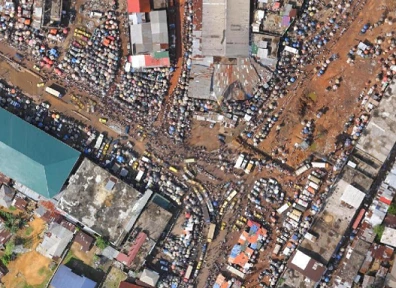 Monrovia's busy Duala Market, taxis, traffic, people
Monrovia's busy Duala Market, taxis, traffic, people
If you walk through the Duala Market, the largest and most popular wholesale market in Monrovia, Liberia, in the morning, you will see vehicles crowding the streets and shopkeepers setting up their stalls. The shops spill out of the cluster of buildings that once formed the entire market and into the street for a kilometer-and-a-half stretch. Since its founding, the market has expanded to nearly 12 times its original size.
By midday, the market is packed. Somewhere between 1,000 and 3,000 vendors sell their goods to tens of thousands of customers here, making it a hub of economic activity in Greater Monrovia. The market is a key source of food and goods for residents and of income and livelihoods for vendors from across the region.
But in recent times, congestion and pollution have dampened the market’s productivity. Crowded streets make it difficult for vendors to deliver goods, while piles of trash, clogged drains, and inadequate waste facilities discourage shoppers. To help change that, the World Bank partnered with the Humanitarian OpenStreetMap Team (HOT), iLab Liberia, and local stakeholders—including the government, market association, vendors, Women in Informal Employment Globalizing & Organizing (WIEGO), and others—meeting in late 2019 to explore existing sources of pollution. They focused on waste, infrastructure facilities, and food loss—and on the relationship of these factors with market productivity. The results are included in a report, Open Mapping for Productivity & Pollution Impacts on the Duala Market.
By using a new approach, combining remote-sensing data (drone-mapping, machine-learning AI, street imagery, and the like) with on-the-ground vendor surveys and focus-group discussions, researchers in this study developed a baseline dataset on the existing market infrastructure and operations; spatial and temporal flows of transport, goods, people, transactions, waste, and services; diverse stakeholder views; and much more. The project began with a multi-stakeholder workshop to promote collaboration and obtain the permits required to conduct fieldwork. COVID-19 cases started to emerge in Monrovia as researchers analyzed data on the Duala Market's footprint, giving them an early chance to include pandemic-related findings.
Here’s what the team found through data analysis:
- Food loss is a significant factor that affects market pollution and productivity. Much of the loss arises from a lack of refrigeration and poor hygiene. Vendors can lose between 2–8% of their total revenues per day from food contamination. Without storage, vendors must replenish their stock daily, but the crowded streets often impede deliveries.
- Contaminated food is a big contributor to solid waste, one of the major sources of pollution in the market. The market’s activity has long outpaced the capacity of its waste-collection points. Six informal dumping sites have begun where low-lying wetlands border the road, creating groundwater-pollution concerns. The individual waste collectors in the market cannot handle the amount of garbage it generates.
- Poor sanitation facilities impact worker health and productivity. There are only 12 toilets and 17 water points near the market. Based on population estimates, each facility serves between 2,000–10,000 users. Of the existing facilities, 11 of the 12 toilets available are within 100 meters of the wetlands and lack the proper infrastructure to prevent contamination or future epidemiological risks. About 1.3 km of stormwater drains exist in the market, but they are not systematically arranged; nearly all of them have no existing outflow or are blocked by debris.
- Slow traffic and congestion pose public health, pollution, and productivity risks. Most merchandise is transported by taxi and delivery truck. There are no designated spots for unloading, so vehicles stop wherever they can, blocking traffic. The lack of sidewalks and heavy foot traffic cause further congestion.
- Congestion has left the market particularly exposed to COVID-19 and other communicable diseases. The density of people in the market is almost double that of the city, and the market faces an influx of motor and foot traffic every day. Combined with the lack of sidewalks, haphazard placement of stalls, and lack of hand-washing stations, the market’s conditions foster swift spread of the virus.
Kindly note: This study pioneered the community mapping of a combination formal/informal market in a city. Others can use the data to design interventions for local economic development and recovery in post-pandemic cities. As the data showed the Duala Market to be a COVID-19 contagion hotspot, some of its data was used to propose early recommendations to the local government for avoiding the spread of the virus and keeping the market open during lockdowns. Researchers can apply the study’s openly available dataset to plan and prioritize investments in urban environments, including that of the Duala Market.










Join the Conversation